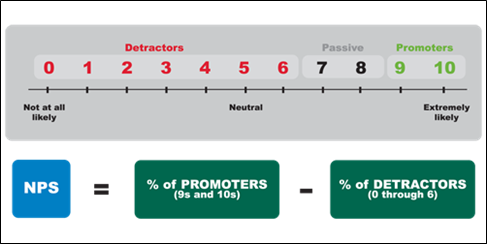What is NPS?
The net promoter score (NPS) is an index ranging from negative 100 to 100 that measures the likelihood of customers to recommend a company’s products or services to others. It is used as a proxy for gauging the customer’s overall satisfaction with a company’s product or service and the customer’s loyalty to the brand.
NPS goals and methodology
Goals
- Provide a differentiated customer experience.
- Better predict customer behaviors.
- Grow and develop your most important customer relationships.
Methodology
- NPS measures customer loyalty, not just satisfaction.
- Research has shown that up to 70% of customers who defect from a company have stated that they were satisfied on previous customer surveys.
- Small differences in retention rate equal large differences in customer lifetime value.
- Best models are based on loyalty data and subsequent financial impact, not current loyalty and financial history.
Note: Studies have measured differences between a loyal customer and a satisfied customer. In short, customer satisfaction is not the leading indicator of customer retention.
How is NPS measured?
To calculate NPS, take the percentage of customers who are promoters and subtract the percentage who are detractors.

Example:
50 customer surveys received:
- 15 are promoters (30%)
- 5 are detractors (10%)
- NPS = 20% (30% promoters - 10% detractors)
Sage NPS question: How likely is that that you would recommend Sage to a colleague or professional acquaintance?
<0-10 point likelihood>
Business partner NPS question: How likely is that that you would recommend (business partner name) to a colleague or professional acquaintance?
<0-10 point likelihood>
| Defining promoters, passives, and detractors |
| Promoters |
These are people who respond with a nine or a ten. They are most likely to actively "talk up" the company, product, or service to their friends. |
| Passives |
These are the people who respond with a seven or eight. These customers "got what they paid for, nothing more." They do not make many referrals, and when they do, they are likely to be unenthusiastic. Companies should focus resources on "delighting" these customers so some will be converted into promoters. |
| Detractors |
These are people who give a rating of six or below. These people's lives have been diminished due to their interactions with the company. They actively criticize the company to their friends, and if they are locked into a long-term engagement with the company, they also drive up costs as employees address their frequent complaints. Companies need to identify and mitigate the root cause of detractors' concerns, and if there is not a rational solution to these problems, companies must learn not to acquire this type of customer in the first place. |
| Defining promoter, passive, and detractor behavior |
| Promoters |
Promoters are the word of mouth extended marketing force. They'll pay you more money, and are more likely to try new products and services from you. In fact, they've already told you they'd recommend you. |
| Passives |
Passives are ambivalent, indifferent, or neutral toward you, but the key here is that they're susceptible to the competition. They could leave you at any time, and you won't know it because they're not going to tell you. |
| Detractors |
Detractors will identify things that you need to fix, so they are really important in that respect. If you address and fix their issues, you can turn them into promoters, they'll stick with you longer, and they'll make you, over the long run, more profitable. You must listen to your detractors. If you don't take action on what they have to say, they could cause damage to your brand. |
Why use the NPS model?
Higher retention rate: Detractors generally defect at higher rates than promoters, which means that they have shorter and less profitable relationships with your company. Rescue those detractors—turn them into promoters—and experience higher margins.
Higher margins: Promoters are usually less price-sensitive than other customers because they believe they’re getting good value overall from your company. The opposite is true for detractors, who are more price-sensitive.
Higher annual spend: Promoters buy more, more often, than detractors do. They tend to consolidate more category purchases with their favorite supplier. Promoters’ interest in new product offerings and brand extensions also exceeds that of detractors or passives.
Greater cost efficiencies: Detractors complain more frequently and consume more service resources. In contrast, promoters reduce customer acquisition costs by staying longer and helping to generate referrals.
Greater word of mouth: What proportion of new customers selected your firm because of reputation or referral? The lifetime value of those new customers, including any savings in sales or marketing expense, comes from promoters. If you’re using the net promoter model, you’ll attribute 80% to 90% of referrals to promoters. To the contrary, detractors are responsible for 80 to 90% of negative word of mouth.
“Except in a few rare instances, a complete and extraordinary customer experience is the key to securing customer loyalty and generating superior long-term financial performance.” ~Harvard Business Review |


